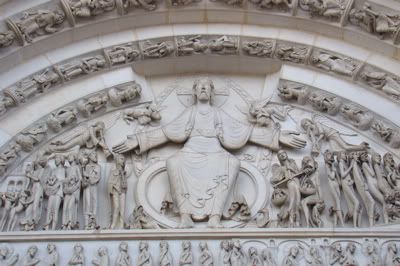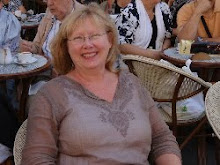
Central tympanum of the narthex of Ste-Marie-Madeleine
The monastic brother, hands lightly clasped at his chest, moved from tourist to tourist, speaking to each in a low voice. We were standing in the transept of the Basilique Ste-Marie-Madeleine in Vézelay (a UNESCO world heritage site), examining the chapels that radiated off the altar space. He spoke quickly and quietly, so the only word that I could catch was fermé (closed). Apparently a service was going to commence soon and they wanted us to vacate the chancel area.
This basilica, first placed on this high hill amid the Morvan forests in Burgundy in the 9th century, gained its renown as a major launching spot for crusade movements and as a pilgrimage destination on the road to Santiago de Compostela because it claimed to have bone relics of Mary Magdalen. In the 13th century it began to lose its prestigious position when another abbey in Provence declared that they really had the true bone relics of Mary. But the faithful continued to come and worship. Brad and I had just missed by a couple of days the annual Festival of Pilgrims. It was those relics I was about to visit in the underground crypt when I was shooed out along with the rest of the camera-toting tourists. My curiosity was piqued a bit because I had yet to visit a church in France that had mid-day services on an average Tuesday. Still eager to see the crypt, I decided to rest my feet until it was over.
A parade of monks in the long white robes of the Brothers of Jerusalem and nuns in all-white habits and veils entered through a side door, arranging themselves on either side of the linen-draped altar. Without any signal, a single, clear voice began a chant to give glory to God. Other voices joined in until a polyphonic chorus filled this sacred space. One by one the tourists still snapping pictures paused. Many took a seat near me. Town residents scurried in and quietly offered a knee before taking a seat for what was clearly a familiar ritual to them.
The lead of the chant passed from one brother or sister to another, first with a solo recitation and than a choral response. This was a monument built for pilgrims more than any other church I had entered in this country. With a nave only 10 meters shorter than the grand Notre-Dame of Paris, it was devoid of most decorations except for the elaborate tympanums on the façade over the three portals leading from the narthex to the nave and carved with figures of the apostles and the people of the world who hear Christ’s message. The carved capitals on the massive pillars holding the Romanesque arches depicted Bible stories as well as mythological creatures to educate those pilgrims as they made their way down the aisle to their goal of the sacred relics.
The chant rose and fell in rhythm while the brothers and sisters remained perfectly still. Although I did not understand the language, my soul was pulled a step closer to heaven with each faultless note. The light bounced off the white stone of the interior. Our bed and breakfast hosts had told us to come early in the day because the light was special. I saw what they meant. The nave had been constructed so that at the summer solstice the light flowed through the upper windows and shown directly on the altar. The solstice had passed, but the effects were still present. The dance of sun on stone illuminated the spirit of the pilgrim as much as the sacred site.

The musical supplications wove through the space and my mind. Where are these serendipitous moments in my daily life? Do I just move too fast to recognize them or do they only occur when I step outside of the familiar? What is my pilgrimage route? Will I recognize it when I get there? For the moment, though, the only journey I was prepared to take was one down the narrow stone streets to a café for lunch. I had not seen the relics; the light and the chanting were all I needed. As Brad and I ate, we heard the bells that had rung after services for centuries and we watched the barn swallows circle and dive as they fed the outstretched beaks that poked out of the mud homes hanging precariously under the stone eaves of the buildings around us. This was one sacred life ritual that had been performed even longer, centuries before the first pilgrims ever hit their knees on the steps at the top of the hill.
(Click on the highlighted links to see photos so much more detailed than I could ever do)





![Grace [Eventually]: Thoughts on Faith](http://photo.goodreads.com/books/1166504427s/12542.jpg)








